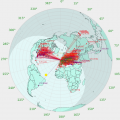The KiwiSDR 2 online store is open for orders! Please visit kiwisdr.nz
G8JNJ
About
- Username
- G8JNJ
- Joined
- Visits
- 3,311
- Last Active
- Roles
- Member
- Points
- 400
Reactions
-
OpenWebRX [using a transverter/down-converter with the Kiwi]
Hi Lonecrow,
I think the problem could be a very strong out of band VHF Digital TV signal that is being down-converted to a frequency that is being aliased by the KiWi to the frequency range you are seeing.
The reason for trying the Airband filter is to see if it reduces the unwanted signal that may not be suppressed sufficiently by the transvertor's built in filters.
The 30MHz low pass filter will help test to see if the problem is the down-converted un-signal that is being aliased by the KiWi sampling frequency from somewhere around 70MHz to 18MHz.
As I say, it is only a theory at the moment.
Regards,
Martin - G8JNJ -
OpenWebRX [using a transverter/down-converter with the Kiwi]
Hi Lonecrow,
Looking at the spectrum and using the new peak hold function, the noise has a fairly well defined 'shape' that could possibly be a VHF Digital TV transmission using the ATSC standard.
I have a theory about how this could be occurring, but a bit of testing is required to prove it.
First - does the noise go away when you disconnect the Air Band antenna ?
If it does then try.
1. Adding an aircraft band Band Pass Filter to the input of the transvertor.
Something like the "bandpass filter BPF 118-136MHz for Air band" that are sold on Ebay.
2. Adding a 30MHz low pass filter between the transvertor and the KiWi.
Something like the "ZETAGI F27 FILTER ANTI TVI FREQUENCY 0-30 MHZ 300W" or some other CB TVI filter as sold on Ebay
Do either (or both) of these things appreciably reduce the level of the interference ?
Regards,
Martin - G8JNJ -
Last Spectrum persists when all signals removed [fixed in v1.279]
-
Denoiser and Autonotch tick boxes not working on main audio control panel [fixed in v1.278]
-
Any Ideas [AM BCB overload]
Some of the 5GHz link kit I've had problems with in the past used Power Over Ethernet which was very noisy. In fact any POE kit seems to generate a lot of unwanted noise. This is a major issue with my Kernow KiWi http://kernow.hopto.org:8073/ which is currently using a temporary active monopole mounted above a room containing POE kit.
Also some of the Bias Tees that are used with Mini Whips don't have adequate filtering on the DC path, so any noise picked up from the power supply or DC connecting cable gets transferred directly onto the RF path and into the receiver.
However Mini-Whips and other E-Probe antennas tend to be noise magnets due to their unbalanced design and high value of feed point impedance, which makes it very difficult to choke off or completely eradicate noise that is picked up on the feed cable. Balanced active antennas and active loops (which have a much lower value of feed point impedance) are much better in this respect.
Regards,
Martin - G8JNJ -
GPS Problems
Does the KiWI GPS antenna work OK with your other GPS receiver ?
Is the KiWi GPS antenna placed on a metal surface ? This helps because the antenna was designed to sit on a motor vehicle roof which acts as a ground plane / reflector. It doesn't work as well if there is no metal surface below it.
When mounted outside in the clear and on a metal surface the GPS antenna and KiWi receiver can work quite well.
Regards,
Martin - G8JNJ -
On-Line frequency database
Copied from UDXF@groups.io
"You may or may not be aware that the ITU monitoring stations publish their
listening logs on their public website:
https://www.itu.int/en/ITU-R/terrestrial/monitoring/Pages/Regular.aspx
This page describes the purpose of the monitoring activity as well as
allowing you to download the logs as Excel spreadsheets; there's also a
search tool so you can search for logs by frequency and date.
The spreadsheets often include DF bearings with an accuracy indication and
signal strength as well as time, frequency, mode, comments etc.
They often mention the kind of things we like listening to!"
I've previously taken a look at the ITU loggings but they always tended to be a bit of a pin to trawl through.
However the new database search tool is very good. Especially if you are careful about what search parameters you set. You can then click on a individual log entry for even more detail.
It would be even better if you could download the searched results, but maybe someone will get around to writing a scraper tool :-)
Regards,
Martin - G8JNJ -
Advice on sharing RX antennas with 3 SDRs in the most effective way
Be careful regarding some of the commercial active splitters. Their IMD performance is not that good as they often use MMIC chips that can only achieve modest performance.
For example the Elad unit specifies an output IP3 of >24dBm, which is not particularly good, and would be typical of something using a PGA-103+ or similar as the active device which will provide an IMD performance of around an IOP2 of +50dBm and IOP3 of +30dBm.
My suggestion would be to use something like the DX Engineering RPA-1 followed by a Mini-Circuits splitter.
I've built a copy of the RPA-1 and it works well from about 10KHz to 40MHz and I have measured the IMD performance as an IOP2 of +92dBm and IOP3 of +45dBm.
Details are on my Active antennas web page.
https://www.g8jnj.net/activeantennas.htm
For GPS splitting you can use active L-Band splitters that were originally designed for distributing satellite TV services.
https://cpc.farnell.com/global-communications/split4af/4-way-active-splitter/dp/SE00009
I used this one but modified by cutting some tracks and adding an internal regulator so that it provided +5v out to feed the GPS antenna
Regards,
Martin - G8JNJ -
On-Line frequency database
Copied from UDXF@groups.io
"You may or may not be aware that the ITU monitoring stations publish their
listening logs on their public website:
https://www.itu.int/en/ITU-R/terrestrial/monitoring/Pages/Regular.aspx
This page describes the purpose of the monitoring activity as well as
allowing you to download the logs as Excel spreadsheets; there's also a
search tool so you can search for logs by frequency and date.
The spreadsheets often include DF bearings with an accuracy indication and
signal strength as well as time, frequency, mode, comments etc.
They often mention the kind of things we like listening to!"
I've previously taken a look at the ITU loggings but they always tended to be a bit of a pin to trawl through.
However the new database search tool is very good. Especially if you are careful about what search parameters you set. You can then click on a individual log entry for even more detail.
It would be even better if you could download the searched results, but maybe someone will get around to writing a scraper tool :-)
Regards,
Martin - G8JNJ -
On-Line frequency database
Copied from UDXF@groups.io
"You may or may not be aware that the ITU monitoring stations publish their
listening logs on their public website:
https://www.itu.int/en/ITU-R/terrestrial/monitoring/Pages/Regular.aspx
This page describes the purpose of the monitoring activity as well as
allowing you to download the logs as Excel spreadsheets; there's also a
search tool so you can search for logs by frequency and date.
The spreadsheets often include DF bearings with an accuracy indication and
signal strength as well as time, frequency, mode, comments etc.
They often mention the kind of things we like listening to!"
I've previously taken a look at the ITU loggings but they always tended to be a bit of a pin to trawl through.
However the new database search tool is very good. Especially if you are careful about what search parameters you set. You can then click on a individual log entry for even more detail.
It would be even better if you could download the searched results, but maybe someone will get around to writing a scraper tool :-)
Regards,
Martin - G8JNJ





